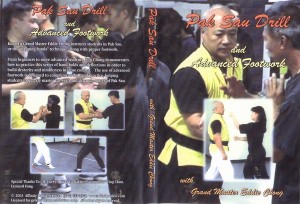What it’s about:
Master Sifu Eddie Chong demonstrates and provides the basics of the Pak Sau Drill and advanced foot work in the Wing Chun Kung Fu system.
Comments:
As in all martial art styles there are training drills which are specific to the development of skill for which a system is known for, Wing Chun is no exception. However, training in the basic hand drills in this martial art system are unique, they are designed to provide development in sensitivity as well as sharpening one’s awareness in the application of technique. Master Sifu Eddie Chong provides an excellent introduction into this training art.
 The Pak Sau drill sequence is designed to teach one to block and hit at the same time. Although the blocking in Wing Chun is a misleading term, one does not block…you are either covering or hitting…the cover is actually a hit! This is what makes the Wing Chun such a unique fighting system. The Pak drill sequence teaches you to use both hands simultaneously. Master Chong’s shows the learner the basic and intermediate skills associated with this training sequence. Offense and defensive applications are learned in partner practice. There are of course differences in how this drill is applied in training, some teachers will express variations in its basic flow of movement, however, the purpose of style or expression of sequence in the drill is the same.
The Pak Sau drill sequence is designed to teach one to block and hit at the same time. Although the blocking in Wing Chun is a misleading term, one does not block…you are either covering or hitting…the cover is actually a hit! This is what makes the Wing Chun such a unique fighting system. The Pak drill sequence teaches you to use both hands simultaneously. Master Chong’s shows the learner the basic and intermediate skills associated with this training sequence. Offense and defensive applications are learned in partner practice. There are of course differences in how this drill is applied in training, some teachers will express variations in its basic flow of movement, however, the purpose of style or expression of sequence in the drill is the same.
There is some conjecture in how one holds the “Sun” fist; does one direct the knuckles of the hand upward toward the opponent’s head or is the hand kept straight and is directed toward the middle Tan Tien. This is particularly evident in the Lap Sau drill and when the forearm/fist is resting forward on an opponent’s Bong Sau. Some teachers want you to hit with the upper two knuckles of the hand and others want you to use the lower two knuckles of the hand. So which is right? If you’re a beginning student you do what your teacher tells you…later you may explore the differences.
Master Chong explains the basics of the Lap Sau drill and shows how the hands are held to maximize coverage and application of technique. Here in this DVD the Pak Sau hand is taught within Lap Sau sequences. Some teachers chose to teach these drills as separate entities. The drills are essentially intended for the learner to use inside and outside bridge techniques. In the Pak Sau drill demonstrated by Chong, there are three basic sections in the sequence. Variations in this sequence are shown in case the attack sequence changes. Blind fold training is included in the drill, it can start early in the practice, however, care should be taken during the early stages of this kind of training, making sure one’s partner is not injured. Again, the purpose of the drill is to develop sensitivity; it’s not a “Rock’em, Sock’em” exercise. Chong also shows how one may change hand techniques, during the Pak Sau sequence using Lan Sau, Bil Sau and palm strike techniques.
Some teachers only show this drill in a stationary posture…this of course is important in the beginning, however, Chong incorporates movement in later stages of the drill, that is demonstrating the stepping in and out sequence during the execution of the Pak Sau hands. In reality your opponent can change his position, one must also learn to adapt to this kind of situation.
In addition to the Pak Sau Sequences advance foot work training is included in this DVD. Chong’s emphasizes the fifty percent weight on each leg…he does not apparently use the empty stance posture where ninety eight percent of one’s weight is on the back leg. This is a matter of personal choice…as he would say “to each his own.” The foot work practice is done in all four directions and is accomplished effortlessly whether an opponent is circling you or coming straight in. The movements can also be done in a diagonal direction. The stepping patterns are shown by Master Chong in normal and slow motion sequences. It’s evident in Chong’s demonstration that Pak Sau training and foot work is a coordinated skill; it only can be achieved with practice.
This DVD provides excellent training material on the basic skills which Wing Chun practitioners must learn. I recommend the purchase of this drilling DVD for anyone who desires to learn different ways one may train in the Wing Chun Kung system.
Technical Specifications:
Title: Pak Sau Drill and Advanced Footwork
Presenters: Eddie Chong
Region: all
Number of disc: 1
Length: 00:43.53
Language: English
Rating scale 1-5:
DVD rating: 4 out of 5
Production Quality: 3.5
Sound Quality: 3.5
Video Quality: 3.5
Material covered: 5
Instructional qualities: 5
Content Overview: Wing Chun Kung Fu – Pak Sau Drill and Advance Footwork.
- Introduction
- Training and Background of Master Sifu Eddie Chong
- The Ip Man Influence
- The Pan Nam Influence
- Purpose of the Pak Sau training sequence
- To demonstrate the extent of hand techniques
- Pak Sau training enhances the training of more advanced hand techniques
- Offensive and Defensive aspects of the Pak Sau Dill
- Training and Background of Master Sifu Eddie Chong
- Basics of the Pak Sau Drill
- The lap Sau Sequence
- Forward punch and Bong Sau defense
- Position of the Wu Sau hand
- Position of the shoulders
- The Pak Sau sequence
- Basic Blind fold training
- Pak Sau Drill
- The basic sequences
- Counter movement to an opponent’s tightly held wrist grab
- Using the inside and outside Pak Sau technique
- unching and using a turning posture against an elbow grab
- Advancing forward during the Pak Sau Drill
- Changing direction as one’s opponent moves backward
- The purpose in closing the gap
- Demonstration of doing the Pak Sau at a fast pace
- Using the Jet Sau and Lan Sau hands in the drill
- The drill begins with the Lap Sau sequence
- Using a Crane technique to lock bar and lock an opponent’s shoulder
- Redirect a punch, pulling and hitting with the elbow
- Chopping down from a Bong Sau and hitting in the inside
- Using a Tan Sau against an over extend punch
- Defensives against a wrist grab.
- Defense against a punch, turn and palm strike
- Strike down against an opponent’s strong arm
- The lap Sau Sequence
- Advance Footwork
- Proper stance and posture
- Weight distribution – 50 percent on each legs
- Moving in four directions
- Moving as the opponent changes direction
- Never expose your back to your opponent
- What to do as your opponent moves to your right or left side
- What to do if your opponent rushes forward
- Advance footwork done in slow motion
- Footwork sequences are repeated
- Concluding remarks on the coordinated movements of Pak Sau and Footwork
Reviewer: George Hernandez
Date: 12/23/2011
Buy the Eddie Chong DVDs on Everything Wing Chun
